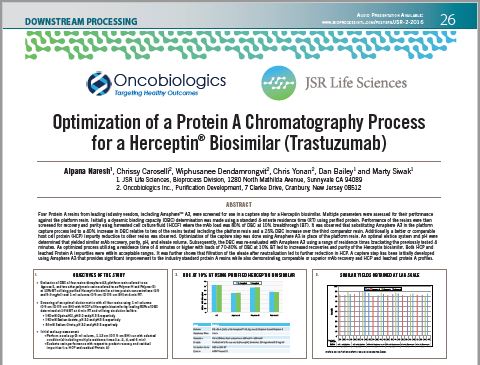Voices of Biotech
Podcast: MilliporeSigma says education vital to creating unbreakable chain for sustainability
MilliporeSigma discusses the importance of people, education, and the benefits of embracing discomfort to bolster sustainability efforts.

Sponsored by JSR Analytical
Four Protein A resins from leading industry vendors, including Amsphere™ A3, were screened for use in a capture step for a Herceptin biosimilar. Multiple parameters were assessed for their performance against the platform resin. Initially, a dynamic binding capacity (DBC) determination was made using a standard 4-minute residence time (RT) using purified protein. Performance of the resins were then screened for recovery and purity using harvested cell culture fluid (HCCF) where the MAb load was 80% of DBC at 10% breakthrough (BT). It was observed that substituting Amsphere A3 in the platform capture process led to a 40% increase in DBC relative to two of the resins tested including the platform resin and a 25% DBC increase over the third comparator resin. Additionally, a better or comparable host cell protein (HCP) impurity reduction to other resins was observed. Optimization of the capture step was done using Amsphere A3 in place of the platform resin. An optimal elution system and pH were determined that yielded similar mAb recovery, purity, pH, and eluate volume. Subsequently, the DBC was re-evaluated with Amsphere A3 using a range of residence times bracketing the previously tested four minutes. An optimized process utilizing a residence time of four minutes or higher with loads of 70-80% of DBC at 10% BT led to increased recoveries and purity of the Herceptin biosimilar. Both HCP and leached Protein A impurities were within acceptable ranges. It was further shown that filtration of the eluate after neutralization led to further reduction in HCP. A capture step has been initially developed using Amsphere A3 that provides significant improvement to the industry standard protein A resins while also demonstrating comparable or superior mAb recovery and HCP and leached protein A profiles.
You May Also Like